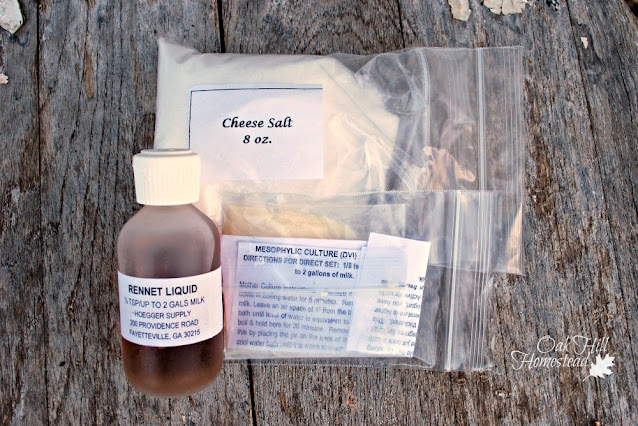Intro
How to make Chevre Cheese
August is National Goat Cheese Month, and just for fun I thought I'd challenge myself to make a different cheese each week.
The kind folks at Hoegger Supply Company, my favorite place to buy goat supplies, said that sounded like fun, and they provided the cheese cultures and other supplies I've been using. My many thanks go out to them.
My Nubian dairy goats, Phoenix, Ziva, Firefly, and Felicity, provided the milk.
What is chèvre goat cheese?
The French word chèvre means goat, and also goat cheese. In my opinion this is one cheese that you have to make with goat milk!
This soft cheese is both tart and tangy, and certainly delicious. For more ways to use chèvre, keep reading.
Chèvre is a soft cheese that can be substituted for cream cheese. It's also a very easy cheese to make. It does take some time, but most of that time is spent waiting.
You can't hurry cheese making!
The chèvre recipe
- 5 quarts milk - I used raw, whole, goat milk
- Liquid rennet
- Mesophylic cheese culture
- Cheese salt (optional)
You'll need this equipment to make chèvre:
- Stockpot that holds at least 6 quarts
- Thermometer with a clip on the side
- Long spoon
- Cheesecloth
- Strainer
Making chèvre
Pour five quarts of milk into a sterilized stainless steel stockpot and heat it to 86°F.
While the milk is heating up, measure 1/3 cup of cold water into a small bowl and add 3 drops of liquid rennet. Set this aside until needed.
I use filtered water. Sometimes something that I'm making - like homemade vinegar or kumbucha - just won't work if I use tap water.
(If you'd like to try making vinegar at home, you can get my free ebook Make Your Own Vinegar for Pennies here.)
When the milk reaches 86°F - not 85° but 86° - remove the pot from the stovetop and add 1/8 teaspoon of direct set mesophylic cheese culture.
Stir once around the pot.
Then add 2 Tablespoons from the rennet that you diluted in the small bowl and stir again. Discard the rest of the rennet and water that you didn't use.
Now you'll leave this pot of milk undisturbed for 8-12 hours. I usually leave mine overnight.
These photos were taken in the morning, ten hours later. The top of the liquid was a smooth layer of curds.
Now, carefully move the curds with a long-handled slotted spoon, and carefully transfer them into a cheesecloth-lined strainer.
There are a lot of curds, nearly all the way to the bottom of the pot.
Draining the curds
Tie up the four corners of the cheesecloth to make a "bag" and suspend it inside a pitcher by running the handle of a wooden spoon through the knot. Then place the spoon across the top of the pitcher.
If you'd rather, you can suspend the bag of curds over a bowl instead. The whey will drain out of the cheesecloth and into the bowl.
Let the whey drain off for 8-10 hours.
Check after eight hours and see if it's dry enough for your liking, or if you need to let it drain longer. It might take more or less time each time you make chevre.
Yield: a little over 32 ounces (2 pounds) from this batch. This is a very productive cheese.
Using Chèvre
As well as using chèvre like cream cheese, this cheese can be seasoned with herbs and spread on crackers or crusty bread.
Chèvre doesn't melt when it's heated, although it does get softer. This makes it nice to use in pasta dishes, or added to salads. Fresh-made chèvre will soften more readily.
If you prefer your chèvre crumbled (the best way to enjoy it on top of salads, pizzas, canapes, eggs and sandwiches), cut cold cheese with a knife into small chunks or crumbles.
You'll find more delicious ways to use chèvre here at Insanely Good.
Store chèvre in a resealable plastic container in the refrigerator. Eat it within one week for the best flavor, but properly stored it can last up to two weeks. If it smells off or if you can see mold forming, discard the cheese.
Chèvre, like all goat cheeses, should be served at room temperature.
You can freeze chèvre for up to six months before it begins to lose flavor. Once thawed, it can be more watery than fresh cheese.
More goat cheeses
If you're looking for a simple, easy soft cheese to start your cheese making journey, try farmer's cheese. With just two ingredients - milk and either vinegar or lemon juice - you'll find this a very beginner-friendly project.
Ricotta cheese is almost as simple and can be made with the leftover whey from making farmer's cheese, or with fresh whole milk for a greater yield. Learn how to make ricotta cheese here.
While mozzarella cheese is a bit more challenging to make, it's definitely a cheese that we all love to eat and stretching the curds is rather fun. Learn how to make mozzarella cheese in this post.
For more self-sufficient posts like this, subscribe to my weekly-ish newsletter "The Acorn" and join me on Facebook, Instagram and Pinterest. I'd love to see you there!
Tips for the Best-Tasting Goat Milk
Keeping Goat Records (with free printables)
15 Ways to Use Goat Milk
~~~~~
My hope is to inspire you, and to encourage your homesteading plans and your dreams of a




















